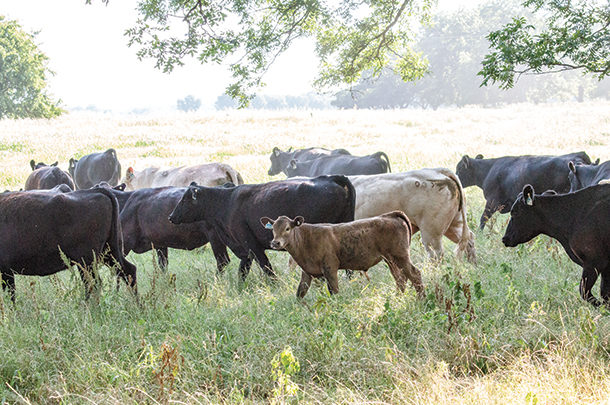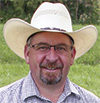What rancher doesn’t want heavier calves or cows that stay in the herd longer? Commercial cattle producers should consider the benefits of heterosis when shopping for their herd sires this year.
Ranching is all about balance. In the arid West, we sometimes struggle with balancing: How does one maintain a small to medium-framed mother cow that will survive and thrive, balanced against the desire for a calf crop that grows fast and meets market expectations?
Selection is the tool of choice when trying to improve highly heritable traits such as frame size, growth and carcass traits. Crossbreeding is the best tool known for improving traits with low heritability such as reproduction and longevity. Crossbreeding has become the standard in corn, chickens, hogs and club calves. Yet, crossbreeding is not universal in commercial cattle production. How does one determine if they should be using this tool in their herd?
The difference between the average of the crossbred offspring and the average of the purebred parental lines is called heterosis. In studies at United States Meat Animal Research Center (USMARC), the calf crop from the cross of two different cattle breeds would be expected to be 16.3 pounds more than the average of their parental breeds.
Maternal heterosis is the term used to describe the heterosis that occurs in crossbred females and is measured in the calf crop. In cattle, the calf crop of crossbred females produced a weaning weight that was 18 pounds heavier than the calf crop of the same bulls mated to purebred cows. Besides producing bigger calves, crossbred cows stay in the herd 1.36 years longer and have .97 more calves than their purebred herdmates.
Maximum heterosis gains occur when bulls of a third breed are used on first-generation crossbred females. The resulting calves have the benefit of both individual and maternal heterosis. In a 1999 study, the calf crop averaged 34.3 pounds (16.3 individual + 18 maternal) more than the offspring of purebred cattle with the same genetic potential.
So with these advantages, why aren’t more ranchers using crossbreeding within the cattle industry? It could be suggested that the lack of crossbreeding is the result of the successful marketing of breed-specific beef. Individuals might claim it is the increased management needed in crossbreeding systems. Herd size, number of bulls needed for natural service and multiple breeding pastures can also impact the way things are done on an individual farm. Another factor is when breeding season occurs. When cows are on range, it becomes harder to manage bull strings.
Here are a couple of suggestions of ways to add some heterosis to your herd while keeping the system relatively simple.
Adding a terminal sire breed to current herd
If you are already using two breeding pastures, such as one for the heifers and another for the cows, try adding a terminal sire to the cow herd during breeding season. This would allow the producer to maintain the cow herd they have developed through producing replacements with the heifer herd. The heifers should be the genetically superior group with the newest genetics. If a larger group of heifers is desired for selection purposes, the first-calf cows could be placed with the heifer herd during the breeding season.
Advantages of this system include putting the terminal sires with the females that are less likely to have calving difficulties. By choosing a terminal sire breed which adds growth and muscling to the calf crop, the resulting calf crop has three advantages as a market calf, a mature mother, highly heritable growth and muscling from the sire, and heterosis from the cross.
Downsides of this option include two groups of market calves: the terminal sire’s calves and the male calves from the heifers. This system requires at least two breeding pastures.
Swapping bulls mid-breeding season
In this strategy, replacements sires are placed with the females for the first 30 days of the breeding season. Those bulls are then replaced with bulls of a terminal sire breed for the remainder of the breeding season. Advantages of this system include only one breeding pasture. Most replacements are chosen from the early calves because they are bigger and more mature under most mating systems. This system produces a more uniform calf crop to sale because the late calves will have the advantage of heterosis to help them catch up with the market calves from the early bulls. A disadvantage with only one breeding pasture: Some heifers will mate with the terminal sire, making calving ease important. Another thing to consider with this system is: More total bulls may be needed.
Purchasing crossbred replacements
With this strategy, all the females are crossbred, the replacement heifers are purchased from a reliable source, and only terminal sires are used. Under this system, the entire calf crop is sold each year. This system allows all the calves to have the advantage of receiving both individual heterosis and maternal heterosis. Other advantages of this option include producing one crop of market calves and only requires one breeding pasture. Downsides of this option include finding a reliable market of replacement females conditioned for your environment.
If given the facilities, the ability to raise replacements and the desire to add the advantage of heterosis in their market calves, ranchers may want to consider using a rotational crossing system.
Two-way rotational cross
With this option, two complementary breeds are chosen. Bulls of breed B are mated to cows of breed A. Heifers retained for replacements are bred to bulls of breed A to produce a calf that is three-quarters breed A and one-quarter breed B. These calves are bred to bulls of breed B. Each succeeding generation is bred to the bulls of the breed opposite of their sire’s breed. Advantages of this system include replacements coming from within the system. Disadvantages of this option are: Only 67% of maximum heterosis is maintained in the system, and minimum of two breeding pastures are needed for natural service.
Increasing the number of breeds in the rotation to three results in increasing the maximum heterosis to 87% but does require more pastures and management to make it work.
Combining a terminal sire with crossbred females from a rotational system would help maximize the amount of heterosis in the market calves, but it does add another layer of complexity for management.
Other things to think about
Bull selection is just as important in a crossbreeding system as in a purebred system. Because expected progeny differences (EPDs) are based on mating within purebred herds, it is important to use crossbred EPD adjustment factor tables to correct for breed effects. These are published regularly by USMARC. Using these adjustment factors allows the EPDs of bulls of different breeds to be accurately compared. This is important in crossbreeding to keep females of different crosses uniform for milk and frame size that is appropriate for one’s operation.
If an individual has the facilities and the training, an artificial insemination program makes matching the right bull and the cows possible without the extra pastures needed in a natural service program.
Crossbreeding is one tool that can help producers develop cows that stay in the herd longer, produce bigger calves and retain the traits needed to survive and thrive in their environment. Local extension offices are a good source for more information about tailoring a breeding system to meet individual producers’ needs and facilities. Using the proper tools is the best way producers can balance the resources with the markets they have.











